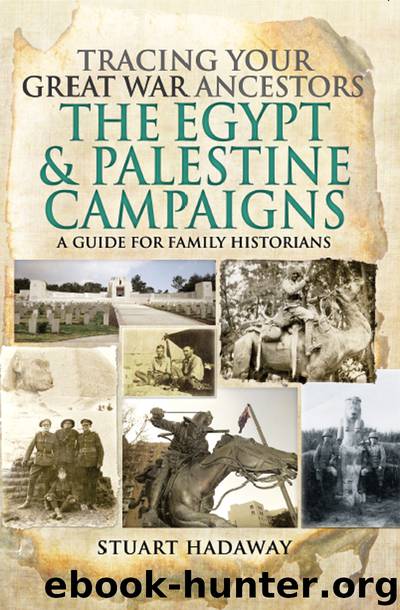Tracing Your Great War Ancestors by Stuart Hadaway

Author:Stuart Hadaway
Language: eng
Format: epub
Publisher: Pen and Sword
Published: 2017-03-06T16:00:00+00:00
TRENCH LIFE
Although the campaigns in Egypt and Palestine can be characterised by broad, open spaces, trench warfare still went on. Generally, it was a pale comparison with that on the Western Front; lines were generally less complex and the barbed wire less prolific, although one exception was the areas south of Gaza in the summer and autumn of 1917. Here the Ottomans dug in deep and well, using the ground excellently and employing not only barbed wire but also thick cactus hedges in front of their lines. In fact, the Ottomans generally excelled at making defensive lines. When Brigadier General Sir Guy Dawnay visited the sites of the actions at El Magdhaba and El Magruntein, on the Egypt– Palestine border, he was amazed. At El Magruntein he found ‘a splendidly selected position on a small rise in a gently rolling, grassy plain; absolute “glacis” slopes all round – not a mouse could move up to attack it without being seen from ever so far.’ At El Magdhaba, the Ottoman ‘works around the place were the most cunningly sited I have ever seen.You can’t see them at all till you absolutely walk into them. Our artillery could never pick them up.’ (Letter to his wife, 10 March 1917, IWM 10403). Usually the Ottomans were very short of barbed wire, especially in late 1917 and throughout 1918, and this weakened their positions.
The British dug extensive trenches and redoubts along the Suez Canal from the outbreak of the war until well into 1916. Life here could be idyllic. Apart from the usual ‘stand to’ at dawn, attitudes were fairly relaxed, and soldiers could bathe or fish in the Canal, or even just sit and watch the ships go by, like New Zealander S. Nautch of the 1st Battalion, Canterbury Regiment:
It is a wonderful thing to sit and watch the approach, the passing and the fading away of these monsters of the night. The canal [is] a perfect mirror reflecting the stars overhead and the cliffs of the opposite bank. Away to the north the canal stretched straight for 7 miles, away to where sea and sky appear to meet, and the stars of the heavens appear to mingle with their reflections in the waters. (S. Nautch, IWM 12330)
Further into the desert, things were more fraught. As the EEF advanced across the Sinai temporary defences were dug. Usually these were strings of posts rather than continuous lines, and had little or no barbed wire, making them very vulnerable to attack. Occupying them could be nerve-wracking:
Bir el Abd was now the most forward infantry post. It was half-way between Kantara and el Arish – so that the ‘spear head’ of the offensive defensive was making good progress. It was defended by a great ring of outpost positions, each held by a platoon or so, usually with another platoon in support. Night after night we slept in clothes and boots, with our equipment on us, and woke at intervals to peer into the dark for an
Download
This site does not store any files on its server. We only index and link to content provided by other sites. Please contact the content providers to delete copyright contents if any and email us, we'll remove relevant links or contents immediately.
Twilight of the Idols With the Antichrist and Ecce Homo by Friedrich Nietzsche(17720)
CHERUB: The Recruit by Robert Muchamore(1831)
CHERUB: The Fall by Robert Muchamore(1714)
CHERUB: Man vs Beast by Robert Muchamore(1614)
I Capture the Castle by Dodie Smith(1575)
The Edge of the Abyss (Sequel to The Abyss Surrounds Us)(1470)
Black Genesis by Robert Bauval(1320)
A Brief History of Everyone Who Ever Lived by Adam Rutherford(1250)
all by Unknown Author(1243)
Where Do I Start? by Chase Taylor Hackett(1062)
2016 Baby Names Almanac(980)
Painfully Rich by John Pearson(959)
Genetics by Adam Rutherford(923)
How to Argue With a Racist by Adam Rutherford(883)
2011 Baby Names Almanac(844)
Black Hawk Down by Mark Bowden(829)
It's All Relative by A. J. Jacobs(799)
My European Family by Karin Bojs(787)
Spook Street (Slough House) by Mick Herron(785)
